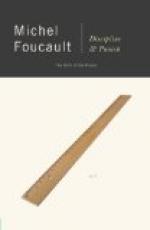|
This section contains 1,977 words (approx. 5 pages at 400 words per page) |

|
Summary
Foucault begins “Docile Bodies” with two opposing images of soldiers from different eras. The seventeenth century soldier was characterized by virtues of strength and courage, as well as a strong body and mannerisms that expressed his “rhetoric of honour” (135). The other image is a soldier from the eighteenth century that is a malleable figure of obedience. This soldier marks all of the features of discipline, in that he acts in a calculated and efficient manner. The comparison between these two soldiers indicates that the age of natural virtuosity was supplanted by a new age of discipline, where the body is seen as an “object and target of power” (136).
Increasing industrialization of Europe brought with it the notion that the body can be “manipulated” like a machine, that can be “shaped, trained, which obeys, responds, becomes skillful and increases its forces” (136). Foucault identifies two...
(read more from the Section 3, Part 1 Summary)
|
This section contains 1,977 words (approx. 5 pages at 400 words per page) |

|




